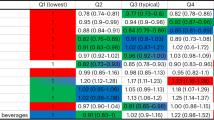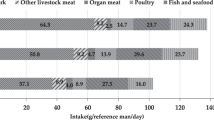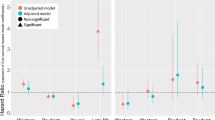Abstract
The aim of this paper is to discuss concepts regarding the nutrition transition (NT), the several stages it has encompassed over human history, dietary shifts it is associated with and its implications to the life-course approach for obesity prevention. NT is a phenomenon characterized by an inversion of the nutrition profile, that is, an increase in obesity and a reduction in undernutrition. Obesity and associated chronic diseases are the most important expressions of NT today. Some important dietary changes happened in the last decades as a result of the complex determinants of NT, such as urbanization, the economic growth dynamic, cultural and behavioral shifts. The NT has involved an increased consumption of caloric beverages, ultra-processed products, animal foods, edible oils and soft drinks, accompanied by a significant reduction in the consumption of fruits, vegetables, pulses and milk. Global obesity prevalence increased from 4.8% in 1980 to 9.8% in 2008 for men, and from 7.9% in 1980 to 13.8% in 2008 for women, representing 205 million men and 297 million women with obesity and 1.46 billion with overweight in 2008. The context of the NT needs to be taken into account when developing effective obesity prevention strategies across the life-course.
This is a preview of subscription content, access via your institution
Access options
Subscribe to this journal
We are sorry, but there is no personal subscription option available for your country.
Buy this article
- Purchase on Springer Link
- Instant access to full article PDF
Prices may be subject to local taxes which are calculated during checkout
Similar content being viewed by others
References
Popkin BM . Global dynamics: the world is shifting rapidly toward a diet linked with non-communicable diseases. Am J Clin Nutr 2006; 84: 289–298.
Kac G, Velásquez-Meléndez G . The nutritional transition and the epidemiology of obesity in Latin America. Cad Saúde Pública 2003; 19 (Suppl 1): S4–S5.
Uauy R, Monteiro CA . The challenge of improving food and nutrition in Latin America. Food Nutr Bull 2004; 25: 175–182.
Rivera JA, Barquera S, González-Cossío T, Olaiz G, Sepúlveda J . Nutrition transition in Mexico and in other Latin American countries. Nutr Rev 2004; 62: S149–S157.
Uauy R, Corvalan C, Dangour AD . Conference on “Multidisciplinary approaches to nutritional problems” Rank Prize Lecture. Global nutrition challenges for optimal health and well-being. Proc Nutr Soc 2009; 68: 34–42.
Ludwig DS . Childhood obesity: the shape of things to come. New Engl J Med 2007; 357: 2325–2327.
Drenowsky A, Popkin BM . The nutrition transition: new trends in the global diet. Nutr Rev 1997; 55: 31–43.
Popkin BM, Nielsen SJ . The sweetening of the world's diet. Obes Res 2003; 11: 1325–1332.
Popkin BM . Patterns of beverage use across the lifecycle. Physiol Behav 2010; 100: 4–9.
Bermudez OI, Tucker KL . Trends in dietary patterns of Latin American populations. Cad Saúde Pública 2003; 19 (Suppl 1): S87–S99.
Monteiro CA, Levy RB, Claro RF, de Castro IRR, Cannon G . Increasing consumption of ultra-processed foods and likely impact on human health: evidence from Brazil. Pub Health Nutr 2011; 14: 5–13.
Nielsen SJ, Popkin BM . Patterns and trends in food portion sizes, 1977–1998. JAMA 2009; 289: 450–453.
Piernas C, Popkin BM . Snacking increased among US Adults between 1977 and 2006. J Nutr 2010; 140: 325–332.
Finucane MM, Stevens GA, Cowan MJ, Danaei G, Lin JK, Paciorek CJ et al. National, regional, and global trends in body-mass index since 1980: systematic analysis of health examination surveys and epidemiological studies with 960 country-years and 9.1 million participants. Lancet 2011; 377: 557–567.
Popkin BM . Understanding global nutrition dynamics as a step towards controlling cancer incidence. Nat Rev Cancer 2007; 7: 61–67.
Popkin BM . Contemporary nutritional transition: determinants of diet and its impact on body composition. Proc Nutr Soc 2010; 70: 1–10.
Andersen LG, Holst C, Michaelsen KF, Baker JL, Sorensen TI . Weight and weight gain during early infancy predict childhood obesity: a case-cohort study. Int J Obes 2012; 36: 1306–1311.
Druet C, Stettler N, Sharp S, Simmons RK, Cooper C, Smith GD et al. Prediction of childhood obesity by infancy weight gain: an individual-level meta-analysis. Paediatr Perinat Epidemiol 2012; 26: 19–26.
Pérez-Escamilla R, Bermúdez O . Early life nutrition disparities: where the problem begins? Adv Nutr 2012; 3: 71–72.
Kac G, Benício MH, Velásquez-Meléndez G, Valente JG, Struchiner CJ . Gestational weight gain and pre-pregnancy weight influence postpartum weight retention in a cohort of Brazilian women. J Nutr 2004; 134: 661–666.
Popkin B . The World is Fat. Avery, 2009, p. 21.
Acknowledgements
RP-E has received grant support from the National Institutes of Health and the Centers for Disease Control and Prevention. GK is a research fellow from the Brazilian National Council for Scientific and Technological Development (CNPq). The publication was supported in part by the Government of Aruba, the Obetech Obesity Research Center, the Pan American Health Organization and the Pan American Health and Education Foundation. This paper is derived from the workshop ‘Education for childhood obesity prevention: A life-course approach’, co-organized by the Panamerican Health Organization (PAHO) and the Panamerican Health and Education Foundation (PAHEF), and held on 14 June 2012 in Aruba, as part of the II Pan-American Conference on Childhood Obesity (http://www.paco.aw/).
Author information
Authors and Affiliations
Corresponding author
Ethics declarations
Competing interests
The authors declare no conflict of interest.
Rights and permissions
About this article
Cite this article
Kac, G., Pérez-Escamilla, R. Nutrition transition and obesity prevention through the life-course. Int J Obes Supp 3 (Suppl 1), S6–S8 (2013). https://doi.org/10.1038/ijosup.2013.3
Published:
Issue Date:
DOI: https://doi.org/10.1038/ijosup.2013.3
Keywords
This article is cited by
-
Micronutrient status and associated factors of adiposity in primary school children with normal and high body fat in Colombo municipal area, Sri Lanka
BMC Pediatrics (2021)
-
Age patterns in overweight and wasting prevalence of under 5-year-old children from low- and middle-income countries
International Journal of Obesity (2021)
-
The Influence on Population Weight Gain and Obesity of the Macronutrient Composition and Energy Density of the Food Supply
Current Obesity Reports (2015)
-
The epidemic of childhood obesity in the Americas must be stopped: Governmental and PAHO leadership are crucial
International Journal of Obesity Supplements (2013)



